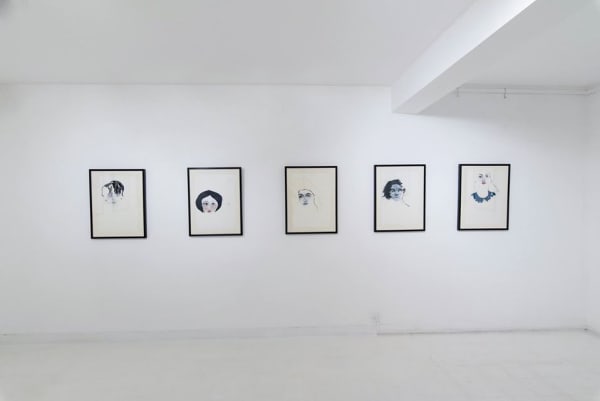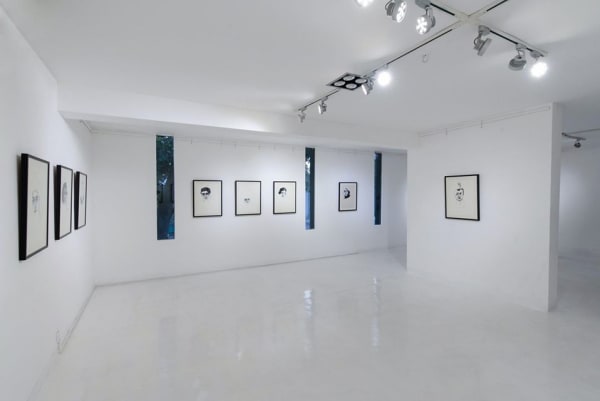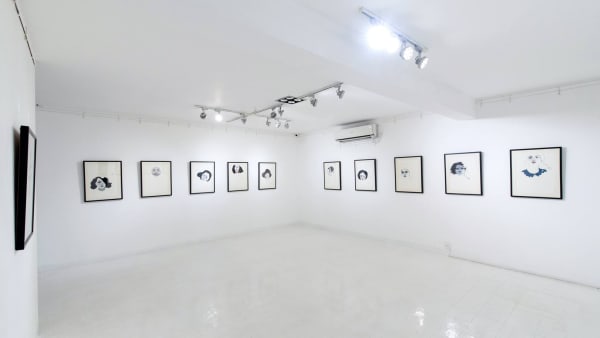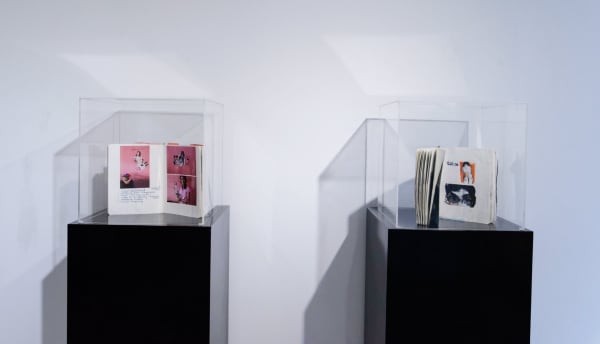It's Like Someone Took My Soul: Fabienne Francotte
“Let me tell you how I draw. Late at night. No light. Eyes wide open. Straight to the point. Like a cat!”
Belgium-born artist Fabienne Francotte’s practice began 17 years ago while studying calligraphy. The careful composition of writing demanded a strict, ritualistic approach built on strong gesture and balance. This discipline, along with the rigor of a decade spent at the Royal Conservatory of Dance in Brussels under Maurice Béjart, became the foundation of her artistic language. Today, dense, intentional lines have given way to fluidity in her works. Now, it is her subconscious that directs the movements of her hand. Often inspired by the people she meets Fabienne Francotte interprets the chaos of the human condition, unrehearsed.
This body of work titled “It’s Like Someone Took My Soul” functions as a type of contact sheet, like an album of film negatives. Inspired by Fabienne’s personal journey through daily life and the complexities of the Sri Lankan identities she meets, each portrait is a reconstruction of many—never one—individual. The works are infused with the essence of her many interactions, which then, at the time of their creation, spontaneously intermingle with her memories and her mood. While featuring external, physical features, her works lend insight to the inside of each persona. She reveals an interior human world, at times disturbing, but always beautiful. Through her art, Fabienne becomes an unintentional conduit of the soul.
Her portraits are about the characteristics of class, gender, and race. They are a tale of the daily struggle showing distinctive appearances, expressions, and gestures. Her people are everyday and anonymous. Through them, she communicates the conflicting issues in Sri Lanka today: school and education, dreams and weddings, sex and business, silence and fear, courage and dedication, as well as religion and tolerance.
Why does she draw portraits? Like David Hockney says, “Faces are the most interesting things we see. The point where we go inside people—is the face. It tells all.” However, Fabienne doesn’t just draw faces, she draws the head. Faces are about the front of the head. But heads contain the brain and the sense organs. There’s so much more.
For Fabienne, drawing is thinking. It is the language she speaks. She concentrates on the encouragement of free self-expression through drawing, painting, and sculpture. It is this same freedom and empathy that she brings to her time spent at the NIMH in Angoda and at the Siviraja Children’s Development Center for the deaf and blind. Facilitating a “breath of fresh air,” through art making, exploration, and encouragement, Fabienne provides a space for students and patients to confidentially draw outside the lines. Drawing functions as a safety net, giving the students the feeling of being “normal.” Her goal is to combine education, self esteem, and quality of life in each experience with her students.
Marguerite Richards
It’s Like Someone Took My Soul
Fabienne Francotte
16.02.18 – 08.08.18
Saskia Fernando Gallery is pleased to present “It’s Like Someone Took My Soul” by Fabienne Francotte, an exhibition of recent work.
Fabienne’s portraits are best understood as memorials; not of a particular person, political moment or place in time. Instead they are amalgamations or impressions of interactions that meld together individuals she meets, with places, experiences and states of mind. We are made privy to the exchange of these experiences between the subjects and the artist through the titles of the various pieces. From “I Lost my Head as well as my Sex” to “A Good and Decent Woman” the titles of her pieces read as isolated lines of poetry that have been dislodged from their stanzas. They inspire a sense of curiosity and tease the viewer with an absence of context. These works are at once memorials and tools for reconfiguring the notion of what memory can be. By exploring how we remember in the form of transient experiences that manifest in the faces of individuals, Fabienne’s portraits chart a complex path through “an interior human world, at times disturbing, but always beautiful.”
Her portraits are about the characteristics of class, gender, and race. They are a tale of the daily struggle showing distinctive appearances, expressions, and gestures. Her people are everyday and anonymous. Through them, she communicates the conflicting issues in Sri Lanka today: school and education, dreams and weddings, sex and business, silence and fear, courage and dedication, as well as religion and tolerance.
The painter David Hockney reflects on faces as “the most interesting things we see.” It is the “the point where we go inside people…It tells all.” Fabienne Francotte’s pieces ask questions about the face and the stories they tell. What layered histories, contexts and experiences live on a person’s face? What stories live beyond it?











